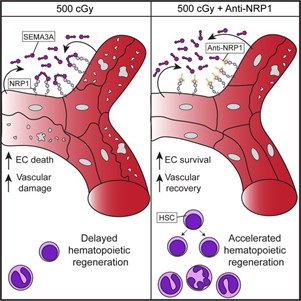Healing the immune system after radiation and chemotherapy
For decades, a weakened immune system has been considered an unavoidable side effect of receiving radiation or chemotherapy. These treatments, while highly effective at killing cancer cells, also deplete the body’s store of blood stem cells and damage the area in the bone marrow where new ones are produced. Blood stem cells, also known as hematopoietic stem cells (HSCs), are critical for a functioning immune system because they give rise to all other blood cells, including white blood cells.

triggered by radiation (500 cGy)
But a shortcut to immune system recovery may be in sight. Last month, former Damon Runyon Fellow Christina M. Termini, PhD, and her colleagues at University of California, Los Angeles, uncovered the signaling pathway that leads to HSC death following cancer treatment—and demonstrated how to block it. The researchers found that, in response to cancer treatment, the bone marrow secretes a protein called Sema3A, a “cell death signal” known for killing excess neurons in the development of the nervous system. In this case, Sema3A induces cell death by attaching to a receptor on the surface of bone marrow cells known as NRP1. The team found that blocking this receptor with an antibody, appropriately named anti-NRP1, resulted in bone marrow cell survival. This, in turn, accelerated regeneration of HSCs.
Dr. Termini’s findings suggest a mechanism for the therapeutic targeting of bone marrow cells to promote faster immune system recovery following cancer treatment. Considering more than half of all cancer patients will undergo radiation or chemotherapy during the course of their illness, this is exciting news indeed.
Read more in Nature Communications.
